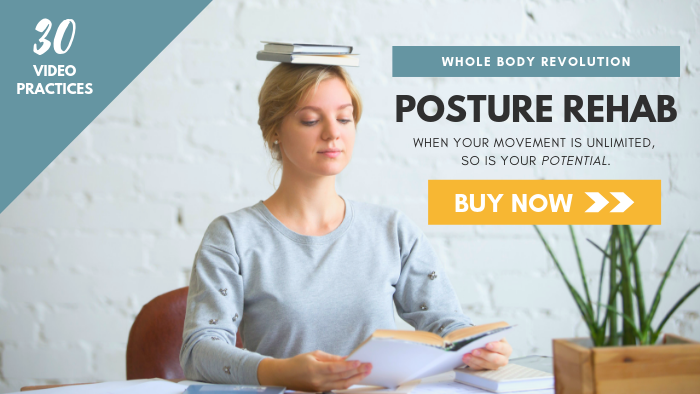Do you have terrible computer posture?
Whether sitting or standing, working all day at a computer can really be a pain in the neck — and the rest of your back, too. If you find yourself rubbing your aching shoulders or nursing a stiff lower back after a full day of peering at screens, you’re in good company.
A hundred years ago, most people were still living a largely agricultural lifestyle full of physical activity. But over the past century, labor has shifted to favor office settings where about eighty percent of work hours are sedentary.
All that sitting and staring at screens is resulting in a lot of terrible posture. Not only is the dreaded computer hunch unattractive, it also strains your spine and causes major backaches.
Fortunately, you don’t have to quit your job and become a forest ranger to escape the computer posture epidemic. By making just a few quick ergonomic tweaks, you can alleviate backaches and prevent future evenings laid up on the couch nursing your sore muscles with a heating pad (and let’s be honest, a stiff drink).
Here are five common computer posture mistakes and how to fix them quickly:
1. Hunching Your Shoulders
Shoulders are the darlings of good posture. Nothing says confident and relaxed like having your shoulders back and down.
But, of course, if relaxed shoulders are posture’s superhero, computers are their arch nemesis. Staring at a glowing rectangle all day has an uncanny way of causing your whole back to round forward so that your shoulders are hunched up by your ears.
Not great. Also, not comfortable. But there is actually an easy fix for this one — and it isn’t about pulling your shoulders back and pinning them in place.
Instead, we’re going to make a tiny adjustment to your alignment. Your shoulder blades rest on your rib cage, and when your chest is sunken (as happens when one sits in front of computers all day), it pulls your shoulders forward, too.
Try this: put one hand on your chest just below your collar bones. Lift your chest up and forward (the forward is especially important or you might find yourself leaning too far back).
Notice that when you lift your chest, your shoulders automatically shift backward without you having to hold them there.
Brilliant!
2. Sitting on A Too-Short Chair
Sitting is a scourge, no doubt. It tightens hip muscles and causes lipids to coagulate in your blood. While we all know that sitting isn’t great for us, modern life is filled with chairs, and standing isn’t always practical.
There are things you can do to mitigate the negative effects of too many hours spent sitting, and the most important of these is to raise the height of your chair seat so that your hips are a bit higher than your knees.
Having your hips about two inches above the level of your knees helps to keep your spine straight with less effort. When your chair seat is too low, it forces your pelvis into a backward tilt.
That translates to a rounded spine that mirrors the shape of a banana — not good for back health.
Try this: raise the height of your chair seat until your hips are positioned two inches higher than your knees when your feet are flat on the floor.
Notice how your lower back straightens automatically in this position.
3. Tucking Your Feet Up Under Your Chair
Sitting is all about relaxing, right? That’s why we do it — to take the weight off of our feet.
Only, you kind of need your feet when sitting, too. According to Marc Hamilton, an inactivity researcher at the Pennington Biomedical Research Center, the electrical activity in your muscles drops to zero when you sit.
That means that your legs turn into flaccid noodles, enzymatic activity dwindles, and good cholesterol levels plummet. Yikes!
Some of the most powerful muscles of your body are in your hips and legs. Keeping them lightly engaged assists your core muscles in supporting your spine.
Try this: put your feet flat on the floor (with your chair seat positioned higher than your knees, of course). Lean forward and backward a few inches. Then, tuck your feet up under your chair and try the same thing.
You’ll notice that having your feet flat on the floor absorbs some of the shifting weight of your torso, taking a lot of strain off of your back and core muscles.
4. Sitting on A Too-Soft Chair
While the overstuffed recliner in the corner may beckon to your need for comfort, trust me on this. Your spine will be a lot happier if you sit on a firm surface rather than something that sucks you in like quicksand.
Like the foundation of a house, your pelvis needs a firm base of support in order to maintain good alignment. You wouldn’t build your house on shaky ground and then spend all your time bracing the ever-collapsing walls.
The same is true for your body.
Try this: choose a chair with a firm enough seat to give you a solid foundation — the flatter the better. Beware of “ergonomically shaped” seats as they rarely work for every body type. It’s best to start with a flat, fairly firm base and add bolsters as necessary.
Avoid sitting on stability balls. They’re too squishy. Of course, some padding over the support is fine to alleviate the pressure on your sitting bones. Don’t go too crazy with it, though.
5. Sitting on Your Tailbone
Speaking of soft and squishy chairs, most people have spent so much time sitting on overstuffed sofas that they have no idea how not to sit on their tailbone.
Squishy chairs rock your pelvis backward, putting all of your weight on your sacrum — the bottom-most bone of your spine (well, almost, your coccyx is technically below that, but we’ll just call it all one bone for now).
You’ll know if you’re sitting with your tail tucked under if you feel pressure — and pain — in your lower back while sitting. Another way to check your alignment is to look at your posture from the side (have a friend snap a photo).
Try this: if your spine is shaped like a banana, rock your pelvis forward until you feel pressure on the two pointy bones at its base. These are called your “sitting” bones and should be where your weight is centered.
When you’re properly balanced on your pelvis, you should find it easy to sit up straight and keep your shoulders over your hips.
The Bottom Line
It’s no secret that computer posture isn’t great for our health. But since desk jobs are just part of reality, these five tips will help you keep your posture — and your spine — in tip-top shape.
But if you’re really suffering from the damaging effects of poor computer posture, you need the Posture Rehab system. It’s a complete body overhaul designed to make lasting changes to posture by addressing movement habits.


Leave a Reply